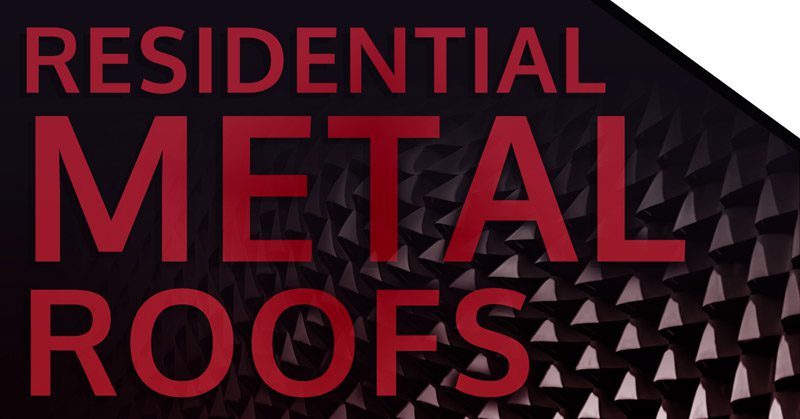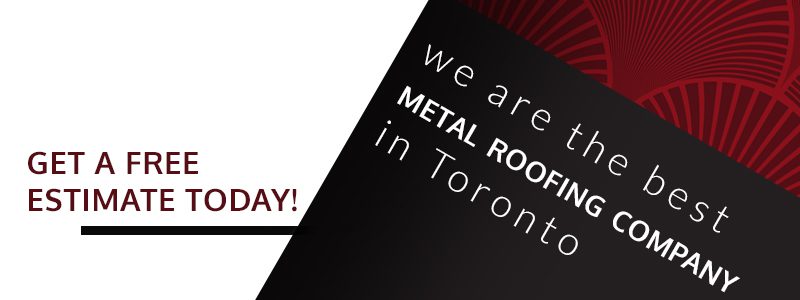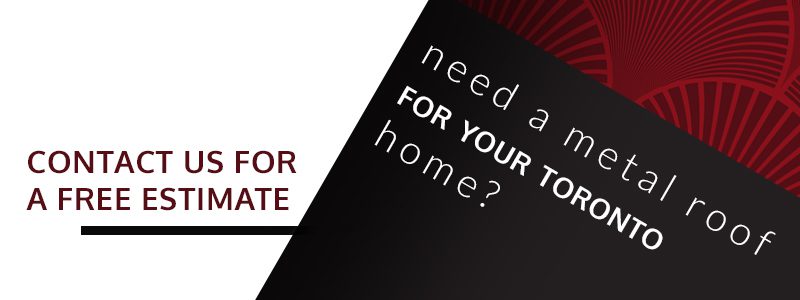Residential Metal Roofing Toronto
Your roof is one of the most important elements of your home. Without a strong roof, you and your family aren’t going to be comfortable or safe. Not only that, you are likely spending way more than you need to in energy bills if your roof needs repair or replacement. Are you looking for residential metal roofing that can stand up to the elements? When it comes to choosing a material for your new residential roof, you’ll be hard pressed to find a better option than metal roofing. If you’re looking for a metal roof for your home in Toronto, we can help you at Top Metal Roofs.


When you are installing a new residential roofing, you have several options, but not all are created equal.
Asphalt
There are most certainly asphalt shingles on homes in your area—most residential houses have this type of roof. The advantages of asphalt include low cost and ease of installation. However, the benefits stop here. With inferior insulation and a short lifespan in comparison to higher quality roofing materials on the market, asphalt is not your best option. Because they are made of petroleum products, they are not generally recyclable, making it the least eco-friendly roofing material. While it is the least expensive way to go, you get what you pay for.
- Style: Fits in with any style, comes in a variety of colours
- Cost: 50 to 150 dollars per 100 square feet
- Lifespan: 15 to 30 years
- Eco-Friendliness: Least eco-friendly option
Wood
There are several different species of wood to choose from when it comes to your roofing materials. You can find shingles in redwood, pine, and cedar, with cedar being the most expensive. This type of roofing can be made by machine or hand cut for a most rustic look. The main concern with wood shingles is how flammable they are when compared to other types of roofing. They often only have a class C fire rating, and many have no ratings at all. That’s why it’s important to educate yourself on the local building codes before electing for this roofing material.
- Style: Best for cottages, ranch houses, bungalows, and historic houses; comes in natural wood colors
- Cost: 100 to 165 dollars per 100 square feet
- Lifespan: 30 to 50 years
- Eco-Friendliness: Better because it’s natural, but it has a bad fire rating and tends to split
Clay/Concrete
This is an extremely heavy type of roofing material, but that does mean it is very durable. They are non-combustible, and come in a variety of shades that help cool the roof and reflect solar energy. Concrete tiles are more flexible in terms of style—they come in a variety of colours and styles that can match a variety of styles. This is one of the greener roofing options.
- Style: European, Mediterranean, contemporary, and ranch style houses
- Cost: 300 to 600 dollars per 100 square feet
- Lifespan: More than 50 years
- Eco-Friendliness: This can be one of the most eco-friendly roofing materials, but only if a local source is available
Slate
Slate is another very heavy roofing material. That being said, it is non-leaching and very long-lasting. Recyclable and easy to repair, slate is beautiful but highly costly roofing material. If you have a bigger budget, you can find slate tiles in dark colours, which can work against you on the hotter days of summer by attracting heat.
- Style: French, Colonial
- Cost: 550 to 1,000 dollars per 100 square feet
- Lifespan: 50 to 100 years
- Eco-Friendliness: Slate is a sustainable roofing material with very little environmental impact.
Fiber Cement
Fiber cement is a composite of concrete, clay, and wood fiber. This are essentially a lighter version of concrete tiles. Durable and fireproof, this roofing material is available in many different colours and styles. That being said, you have to be careful with this type of roofing, as it can easily break in colder climates like we have here in Canada.
- Style: Works with a variety of styles
- Cost: 500 dollars per 100 square feet
- Lifespan: 20 to 30 years
- Eco-Friendliness: Fiber cement is recyclable, non-leaching, and collects water well.
Metal
Your best option in terms of roofing material is metal. Metal roofing has everything. Not only is it stylish, it is the most energy efficient roofing material you can find. Metal roofing is insulating, ensuring that you can keep your home cool during the summer and warm in the winter. You can feel good about the environmental impact of your metal roof because they are most composed of recycled materials. Metal roofs are durable, resistant to the elements, and lighter than most roofing materials.
- Style: Can work with any style of home, but is particularly good for bungalows, contemporary homes, and cottage-style houses
- Cost: Can range from 100 dollars to 600 dollars per 100 square feet, depending on the metal you choose
- Lifespan: 50 years or more
- Eco-Friendliness: Metal roofing is very eco-friendly because it is both energy efficiency and made of recycled materials.


At Top Metal Roofs, we believe wholeheartedly in the ways that you can benefit from metal roofing. This is the preferred roofing material of roofing contractors, not to mention, our happy customers, and it isn’t hard to understand why. Here are just some of the ways metal roofing can benefit you.
Metal Roofing is Long-Lasting
When you are shopping for a roof, one of the most important factors to keep in mind is how long it is going to last you. Yes, asphalt is going to be cheaper in terms of upfront cost, but when it comes to anything involving your home, it’s important to think long term. In the long run, investing in a roof that is going to be able to withstand the elements for decades is a smarter financial decision than paying for roof repair over and over down the line.
Metal roofing is one of the longest lasting roofing materials because metal is so durable. A metal roof can take everything you throw at them, from extreme snowstorms to high temperatures. On top of that, you can have added peace of mind with a warranty.
Metal Roofing is Safe
Many people do not consider safety when they are choosing a roof, but this is an oversight that many don’t realize until it’s too late. Metal roofing is one of the safest materials on the market. First of all, it’s noncombustible, so you don’t have to worry about your roof catching on fire. In fact, metal roofing has the best fire resistance rating of any roofing material. When considering the safety of your family, remember metal roofing.
Metal Roofing is Versatile
While you obviously want a roof that is both durable and safe, it’s also important for it to be aesthetically pleasing. Your home is your castle, so it makes sense that you would want it to be beautiful and reflect your own style. Fortunately, metal roofing is completely customizable to your liking. There are a wide variety of style options, as well as colours. Whether you chose panels or a more traditional roof style with shingles or tile, there are a variety of ways you can make metal roofing uniquely you. You can even find accessories for your metal roof, such as matching trims.
Metal Roofing is Energy Efficient and Eco-Friendly
When you are looking for a roof that can make you feel good about your carbon footprint, opt for metal. First of all, metal roofing is usually 100 percent recyclable and largely composed of recycled materials. On top of that, you can rest assured that your purchase is good for the environment because it’s an energy efficient option as well. The metal reflects the sun’s rays instead of absorbing their heat. This keeps the inside of your home cooler and saves you money on your energy bills.
Metal Roofing is Low Maintenance
Some types of roofs dictate that you will have to keep up with regular maintenance in order for them to not fall into disrepair. This is not the case for metal roofing. Metal roofs require no annual maintenance like asphalt roofs do. To remove leaves and other debris from your roof, all you need is a water hose or pressure washer. We can help you determine what is


Once you have chosen a metal roof for your residential home, you will need to decide which specific type of metal is best for your needs.
Aluminum
Aluminum makes for great residential roofs. First of all, it’s durable and resistant to corrosion, making it one of the longest lasting options. You don’t have to worry about rusting, unlike other metals like steel. In addition, aluminum can be prepainted and cut into essentially any style, so you can completely customize your aluminum roof to your liking. Aluminum roofing is composed of around 90 to 95 percent recycled materials. This makes it the clear winner for many.
- Advantages: Lightweight, doesn’t rust, versatile, energy efficient
- Disadvantages: More expensive than steel and not as hail resistant
Galvalume Steel
Galvalume steel is steel that is coated in an aluminum and zinc alloy. When aluminum and zinc come together, it magnifies the benefits (and disadvantages) of aluminum that are listed above. Because aluminum is so corrosion-resistant, so is galvalume steel. This does cause a slight problem in that it doesn’t protect from scratches as well as galvanized steel. It is also more susceptible to tension bend straining, which refers to when moisture permeates cracks in steel and causes rusting. This makes rust stains form in areas with bends or folds. In time, the corrosion causes further deterioration under the coating. This is why galvalume steel is used most often on roofs without many bends.
- Advantages: Corrosion resistant, strong, relatively inexpensive (but often more expensive than galvanized)
- Disadvantages: Susceptible to tension bend staining, limited profile availability (mostly standing seam or simple shingle styles)
Galvanized Steel
Galvanized steel is steel with a coating of zinc, which provides two types of protection: galvanic and barrier. Galvanic protection is self-sacrificial—it will give itself up rather than allow the base metal to rust. Barrier protection, on the other hand, keeps the elements away from the base metal by providing a protective coating.
Galvanized steel is used more often for roofing than other metals. It costs less, is very strong, and holds paint well. The zinc coating protects galvanized steel from scratches and scrapes. This means that how long your galvanized steel roof lasts is dependent on the thickness of the coating. This is something that we can help you when when we install your new metal roof.
- Advantages: Strong, less expensive, versatile
- Disadvantages: Shorter life span than other metals, may prematurely rust if not used properly, can be more difficult to work with
Copper
One of the most attractive metal roofing options also happens to be the most expensive. Copper is not commonly used for an entire roof—rather, it is more common for accents on roofs. You have most likely seen copper roofing on historic buildings, church steeples, and any buildings that require more elegance. That being said, it is not traditionally used with steel or aluminum. This is because when copper is in contact with different metals, it can begin to deteriorate at a faster pace. With time, the water that comes in contact with the copper begins to stain the metal. Sometimes, lead-coated copper is used to replace copper; however, the concern around lead and health concerns has made this a less popular solution.
Copper is very durable and has an extremely long lifespan—it can last over 100 years, in some cases, which is why it is so popular on important historic structures. These days, there are more people using steel or aluminum for their metal roofing that is coated to look like copper. There are a variety of copper finishes available on the market for people who love the aesthetic of copper, but don’t want to pay the price for it.
- Advantages: Beautiful, extremely durable, easy to work with, long-lasting
- Disadvantages: Expensive, runoff will streak or stain other materials
| Aluminum | Galvalume Steel | Galvanized Steel | Copper | |
| Advantages | Lightweight, doesn’t rust, versatile, energy efficient | Corrosion resistant, strong, relatively inexpensive (but often more expensive than galvanized) | Strong, less expensive, versatile | Beautiful, extremely durable, easy to work with, long-lasting |
| Disadvantages | More expensive than steel and not as hail resistant | Susceptible to tension bend staining, limited profile availability (mostly standing seam or simple shingle styles) | Shorter life span than other metals, may prematurely rust if not used properly, can be more difficult to work with | Expensive, runoff will streak or stain other materials |
| Weight | 45 lbs per square | 100 to 150 lbs per square | 100 to 150 lbs per square | 100 to 150 lbs per square |
|
Thickness |
.019” to .03” | .024” | .018” to .026” | .016”’ to .027” |
| Recycled Content | 90 to 95 percent | 35 percent | 35 percent | 35 percent |

Once you have chosen the type of metal you would like to use, your choices don’t stop there. You can customize your metal roof in a variety of ways so it perfectly matches your needs and style. Here are the considerations you need to make when it comes to choosing your metal roof:
Color
Your metal roofing can be prepainted to be any color you desire. Whether you are looking to add a pop of color or you want a more neutral color to go with the exterior of your home, this choice can completely change the appearance of your home. We can help you determine what color will be best for promoting energy efficiency while being aesthetically pleasing.
Style
One of the biggest advantages of metal roofing is that it can be seamlessly customized to any style you prefer. You can choose from slate, shingle, and tile style panels, true standing seams, or corrugated looks. It is a personal choice how well this fits into your aesthetic, but we can help you figure out what you prefer.
Scale
Scale is an often-overlooked but important aspect of choosing a roof. For example, if you have a home of 50 feet wide, a 24-inch standing seam panel is likely to overwhelm the structure, making it look your roof is significantly larger than your home. Similarly, if your tile profile is very heavy-looking, it is going to look like it is overpowering your house.
As a general rule, it’s best to opt for a heavier look if you have a steeper roof. For example, if your home is Victorian style, a lower profile slate-looking shingle would complement the style best. Alternatively, a lower slope roof such as on a ranch house would look better with a wood-shingle look. Standing seam panels are better on cabins, log homes, or as an accent on a lower roof such as over your porch.
Neighbors
Don’t forget about the context of your home. While you want your home to stand out in terms of beauty, you don’t want it to stick out like a sore thumb. Keep in mind the roofs on the surrounding homes so you don’t end up choosing on that detracts from the value of your home.
There are a lot of factors to consider when it comes to choosing a metal roof, but we would be more than happy to help! Contact TOP METAL ROOFS, for residential metal roofing in Toronto.
